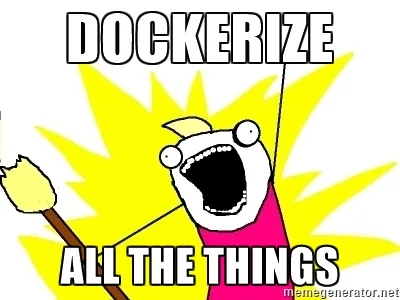Dockerizing my virtual machine
Apr 1, 2021

Docker in EC2
For the last years I’ve used a VM with quite a traditional setup for my private projects: nginx serving some static files, proxying to a node app, plus some other minor utilities.
This VM has been serving me well, it’s economic enough for me not thinking about it for months, and it has been doing its job flawlessly.
But lately I’ve been increasingly adopting docker in production/development environments, and since running docker on Azure seems kind of expensive (I exhausted my Visual Studio subscription credit in about a third of the billing period counting only the cost of ACI - 3 containers in total), I want to try to move my personal apps and prototypes in containers running on a VM.
For this task I’ve choosen an EC2 T3.small; this machine provides me with 2threads (burstable, whatever that means), 2GB of RAM; it should be enough for my needs.
After instantiating my brand new EC2 I started studying what was the most convenient way to run and manage containerized apps; after some exploration I had the awareness that containers where not a good fit for everything.
For example ngnix, I prefer having that running on the VM, it seem less cumbersome to update certificates, plus I made the assumption it would be quicker to test new configurations.
Also static content (A big part of my apps are js client-side), I really couldn’t find a sense in having a container serve static content through a reverse proxy, and having that relayed by another reverse proxy.
So what is left to containerize?
for me it can be summerize with…
Runtimes
- Runtimes used by apps/apis elaborating things on the server, proxied to the users through nginx.
Following is an example of nginx.conf stanza for proxying an api running in docker:
server {
listen [::]:443 ssl;
listen 443 ssl;
server_name localhost api.xxxx.it;
# Protect against the BEAST attack by not using SSLv3 at all. If you need to support older browsers (IE6) you may need to add
ssl_protocols TLSv1.2;
ssl_ciphers ECDHE-RSA-AES128-GCM-SHA256:ECDHE-ECDSA-AES128-GCM-SHA256:ECDHE-RSA-AES256-GCM-SHA384:ECDHE-ECDSA-AES256-GCM-SHA384:DHE-RSA-AES128-GCM-SHA256:DHE-DSS-AES128-GCM-SHA256:kEDH+AESGCM:ECDHE-RSA-AES128-SHA256:ECDHE-ECDSA-AES128-SHA256:ECDHE-RSA-AES128-SHA:ECDHE-ECDSA-AES128-SHA:ECDHE-RSA-AES256-SHA384:ECDHE-ECDSA-AES256-SHA384:ECDHE-RSA-AES256-SHA:ECDHE-ECDSA-AES256-SHA:DHE-RSA-AES128-SHA256:DHE-RSA-AES128-SHA:DHE-DSS-AES128-SHA256:DHE-RSA-AES256-SHA256:DHE-DSS-AES256-SHA:DHE-RSA-AES256-SHA:AES128-GCM-SHA256:AES256-GCM-SHA384:ECDHE-RSA-RC4-SHA:ECDHE-ECDSA-RC4-SHA:AES128:AES256:RC4-SHA:HIGH:!aNULL:!eNULL:!EXPORT:!DES:!3DES:!MD5:!PSK;
ssl_prefer_server_ciphers on;
ssl_session_cache shared:SSL:10m; # a 1mb cache can hold about 4000 sessions, so we can hold 40000 sessions
ssl_session_timeout 24h;
# Use a higher keepalive timeout to reduce the need for repeated handshakes
keepalive_timeout 300; # up from 75 secs default
# remember the certificate for a year and automatically connect to HTTPS
add_header Strict-Transport-Security 'max-age=31536000; includeSubDomains';
ssl_certificate /.acme.sh/api.xxxx.it/api.xxxx.it.cer;
ssl_certificate_key /.acme.sh/api.xxxx.it/api.xxxx.it.key;
location / {
proxy_pass http://localhost:8001; # TODO: replace port if app listens on port other than 80
proxy_set_header Connection "";
proxy_set_header Host $host;
proxy_set_header X-Real-IP $remote_addr;
proxy_set_header X-Forwarded-For $remote_addr;
}
}
- Runtimes used by runners (which are local to the system) to create static resources, throw-away containers that build in docker context, and copy the output to filesystem.
For example, this is a .gitlab-config.yml used by the runner, in the script sections you can see what I mean.
stages:
- deploy
deploy_ec2:
stage: deploy
environment:
name: production
url:
only:
- master
script:
- cd /home/ec2-user/Repos/blog
- git pull
- docker build -t docker-builder .
- docker run --name docker-builder-run --mount type=bind,source=/srv/www/blog,target=/app/public-def docker-builder
- docker rm docker-builder-run
- docker rmi docker-builderThe main success in this setup is that I won’t end up polluting the system with sparse runtimes that might get superseeded but could remain on my system, since all of these are in docker it seems easier to control.
On the other hand what was actually installed (nginx, utilities for certificates, tools for CI/CD, etc.) are somewhat more accessible than if I had containerized them.